TL;DR:
- A few decades ago, children were given the freedom to play with less adult intervention. They learned how to self-regulate and problem solve on their own.
- Now, adults quickly jump in to provide solutions to every problems.
- We have disempowered children by controlling many aspects of their day. Snowplow parents smooth the way for their children by removing possible barriers and problems.
- We can empower children by allowing them opportunities to make decisions on their own. Read a story about how students rallied together to solve a problem.
I’m going to admit something to you right now, readers.
When I do recess duty at my elementary school, I let kids climb the trees. I know that might be shocking to many of you as you think about all that could happen when young children are allowed to do things that might contain some risk. But think about what happens when we don’t allow them to climb trees.
Let me start by saying that I grew up in Brooklyn, NY during the 1960s and 70s. Kids played outside and explored the city without adults watching every game or supervising every outing. The housing project where I spent my first 7 years was a collection of 8-story buildings, and between Building 5 where I lived and Building 6 was a blacktop circle surrounded by benches. Adults would sit on the benches and talk while kids played on the blacktop…sometimes riding and sometimes running. There were accidents to be sure, but when a child fell, it was not the norm for an adult to go to the child. The child would get up and decide…do I go to the adults and risk being made to sit out, or do I brush this off and continue to play?
And this is a key difference to what I see today as the most profound change in how we connect with our children. Adults today seem drawn to go to the child, to help fix the injury. The decision-making control has been removed from the child and centered in the adult.
I am committed to empowering my students, and encourage you to do so as well. Find opportunities to let students experience success and failure. Allow them to go beyond your expectations. Share on X
Building Capacity: Have we “disempowered” students?
When you think about changes in what children control from previous generations to now, you will likely find that the biggest change is that we’ve gone from expecting children to develop decision-making skills to providing every decision for them. I call this disempowering children. I believe the unintended consequence of “helping” kids makes them actually feel like they are incapable of meeting their own needs. Here are some of the ways I see that we have disempowered children (and families):
- Students are reliant on teachers and staff for nearly everything.
- In elementary school, we walk them everywhere.
- We tell students where to sit in the cafeteria.
- We provide all the equipment/games for them at recess.
- Schools provide clothes, shoes, supplies, meals, extracurriculars, etc.
- We “coach” them in sports beginning at a very early age.
I perceived there to be a need to develop a system where students could feel more empowered at school. We can move away from the sense that they were incapable of providing for themselves because we provided everything.
Building Capacity: From the helicopter to the snowplow
To add to this issue, I noticed there was an increasing number of parents who were moving from “helicopter” to “snowplow” status. We all know the helicopter parent. They hover above and around their child to make sure that everything is OK all the time. They are quick to swoop in to right a perceived wrong and ensure that their child receives the experience they expect from the school.
However, increasingly we see snowplow parents at school. A snowplow parent is one that rides in front of their child, removing any impediments in their way as they navigate life. A snowplow parent does not wait for the child to experience something and then try to make it right. The snowplow parent is on the ground, ensuring that all roads are smooth and that the child is spared from experiencing anything negative.
How to build capacity…by letting go.
A goal was to create an experience at school where students were able to develop self-reliance based on their experiences making choices AND feeling the consequences of their actions. It was my personal goal to provide an opportunity for my 5th grade students to see that we did not view them from a deficit perspective, but that we expected them to be able to handle responsibilities. We expected them to have the strength of character to choose activities and behave wisely. And so, we had to change some of our procedures. Some of the changes were:
- Allowing students to walk to and from specials without teacher chaperones.
- Allowing students to choose where they wanted to sit at lunch each day.
- Providing recess with no additional equipment other than the playground equipment and open field. If students wanted to jump rope, play football, etc. they could bring that equipment from home AND be responsible for its use.
- Allow students to climb the trees at recess with the understanding that the activity involved risk.
You might think parents would complain about this and some did. My response was that if they did not want their kids to participate in “free recess” they could instruct their child to do something different. It honestly did not happen more than twice, so I never considered that to be a real barrier to implementation.
[scroll down to keep reading]Building Capacity: Tetherball is stuck in the tree!
So what was the result? Well, I can’t give you scientific data to tell you how students benefited from being given more responsibility. But I can give you an example of building capacity in action. On our playground, there is a tetherball pole that sits right below a good-sized oak tree.
Occasionally, the ball gets wrapped around a branch and becomes stuck. One specific time, the students looked to me initially while looking up at the tree to figure out how to get the ball free. I told them I was too old and too fat to climb that tree, but I would watch and support them. I watched them develop a plan, try out some options, and ultimately devise a solution to get the tetherball free.
It was amazing to see the students support and cheer for each other as they did this on their own. The photos below show the process and the payoff! Click here to see the video of the successful execution of their plan.
I am committed to empowering my students and encourage you to do so as well. Find opportunities to let students experience success and failure. Allow them to go beyond your expectations. And maybe, let them climb the trees!
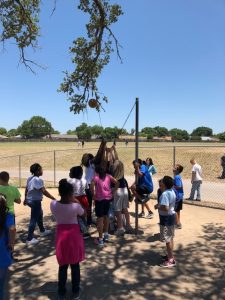
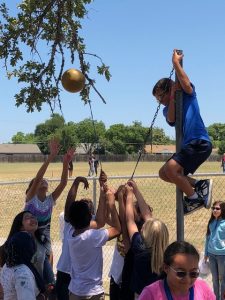
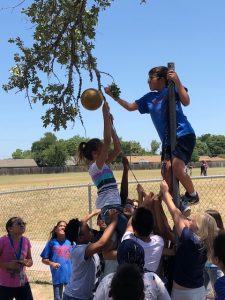
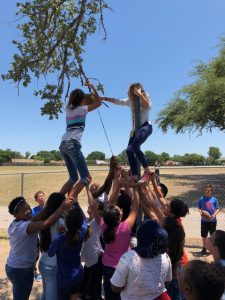
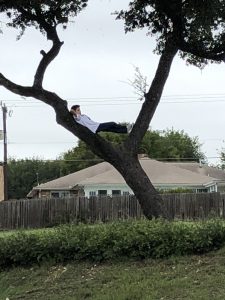
About Martin Silverman
Martin Silverman is a father, grandfather, husband, and long-time educator in beautiful San Antonio, Texas. He is committed to providing the best educational experience for the students and families at Salinas Elementary school where he is principal. Martin has worked in urban, suburban, and rural districts as a teacher and administrator. His interests are in creating and nurturing school culture, providing enriching experiences for students and families, and developing future teachers and administrators.
As a former bilingual teacher and administrator, Martin is committed to providing ELL students with quality programs to develop their unique skills. He hosts a podcast called The Second Question, which highlights educators and provides them a forum to discuss ideas, and to honor the teachers that have influenced their lives.



